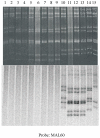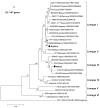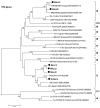Molecular characterization of rotavirus strains detected during a clinical trial of a human rotavirus vaccine in Blantyre, Malawi
- PMID: 22520123
- PMCID: PMC3982048
- DOI: 10.1016/j.vaccine.2011.09.119
Molecular characterization of rotavirus strains detected during a clinical trial of a human rotavirus vaccine in Blantyre, Malawi
Abstract
The human, G1P[8] rotavirus vaccine (Rotarix™) significantly reduced severe rotavirus gastroenteritis episodes in a clinical trial in South Africa and Malawi, but vaccine efficacy was lower in Malawi (49.5%) than reported in South Africa (76.9%) and elsewhere. The aim of this study was to examine the molecular relationships of circulating wild-type rotaviruses detected during the clinical trial in Malawi to RIX4414 (the strain contained in Rotarix™) and to common human rotavirus strains. Of 88 rotavirus-positive, diarrhoeal stool specimens, 43 rotaviruses exhibited identifiable RNA migration patterns when examined by polyacrylamide gel electrophoresis. The genes encoding VP7, VP4, VP6 and NSP4 of 5 representative strains possessing genotypes G12P[6], G1P[8], G9P[8], and G8P[4] were sequenced. While their VP7 (G) and VP4 (P) genotype designations were confirmed, the VP6 (I) and NSP4 (E) genotypes were either I1E1 or I2E2, indicating that they were of human rotavirus origin. RNA-RNA hybridization using 21 culture-adapted strains showed that Malawian rotaviruses had a genomic RNA constellation common to either the Wa-like or the DS-1 like human rotaviruses. Overall, the Malawi strains appear similar in their genetic make-up to rotaviruses described in countries where vaccine efficacy is greater, suggesting that the lower efficacy in Malawi is unlikely to be explained by the diversity of circulating strains.
Copyright © 2011 Elsevier Ltd. All rights reserved.
Figures













Similar articles
-
Emergence of Double- and Triple-Gene Reassortant G1P[8] Rotaviruses Possessing a DS-1-Like Backbone after Rotavirus Vaccine Introduction in Malawi.J Virol. 2018 Jan 17;92(3):e01246-17. doi: 10.1128/JVI.01246-17. Print 2018 Feb 1. J Virol. 2018. PMID: 29142125 Free PMC article.
-
Whole-genome characterisation of G12P[6] rotavirus strains possessing two distinct genotype constellations co-circulating in Blantyre, Malawi, 2008.Arch Virol. 2017 Jan;162(1):213-226. doi: 10.1007/s00705-016-3103-5. Epub 2016 Oct 7. Arch Virol. 2017. PMID: 27718073 Clinical Trial.
-
Diversity of rotavirus strains circulating in Northern Brazil after introduction of a rotavirus vaccine: high prevalence of G3P[6] genotype.J Med Virol. 2014 Jun;86(6):1065-72. doi: 10.1002/jmv.23797. Epub 2013 Oct 17. J Med Virol. 2014. PMID: 24136444
-
Genetic diversity of G1P[8] rotavirus VP7 and VP8* antigens in Finland over a 20-year period: No evidence for selection pressure by universal mass vaccination with RotaTeq® vaccine.Infect Genet Evol. 2013 Oct;19:51-8. doi: 10.1016/j.meegid.2013.06.026. Epub 2013 Jul 4. Infect Genet Evol. 2013. PMID: 23831933 Review.
-
A systematic review of genetic diversity of human rotavirus circulating in South Korea.Infect Genet Evol. 2014 Dec;28:462-9. doi: 10.1016/j.meegid.2014.08.020. Epub 2014 Sep 12. Infect Genet Evol. 2014. PMID: 25218045
Cited by
-
Whole Genome Analysis of African G12P[6] and G12P[8] Rotaviruses Provides Evidence of Porcine-Human Reassortment at NSP2, NSP3, and NSP4.Front Microbiol. 2021 Jan 12;11:604444. doi: 10.3389/fmicb.2020.604444. eCollection 2020. Front Microbiol. 2021. PMID: 33510725 Free PMC article.
-
Efficacy of human rotavirus vaccine against severe gastroenteritis in Malawian children in the first two years of life: a randomized, double-blind, placebo controlled trial.Vaccine. 2012 Apr 27;30 Suppl 1(0 1):A36-43. doi: 10.1016/j.vaccine.2011.09.120. Vaccine. 2012. PMID: 22520135 Free PMC article. Clinical Trial.
-
Molecular Analysis of VP7 Gene of Rotavirus G1 Strains Isolated from North India.Curr Microbiol. 2016 Dec;73(6):781-789. doi: 10.1007/s00284-016-1129-2. Epub 2016 Aug 26. Curr Microbiol. 2016. PMID: 27565145
-
Multiplexed one-step RT-PCR VP7 and VP4 genotyping assays for rotaviruses using updated primers.J Virol Methods. 2015 Oct;223:96-104. doi: 10.1016/j.jviromet.2015.07.012. Epub 2015 Jul 29. J Virol Methods. 2015. PMID: 26231786 Free PMC article.
-
Whole genome analysis of selected human and animal rotaviruses identified in Uganda from 2012 to 2014 reveals complex genome reassortment events between human, bovine, caprine and porcine strains.PLoS One. 2017 Jun 22;12(6):e0178855. doi: 10.1371/journal.pone.0178855. eCollection 2017. PLoS One. 2017. PMID: 28640820 Free PMC article.
References
-
- Parashar UD, Burton A, Lanata C, Boschi-Pinto C, Shibuya K, Steele D, et al. Global mortality associated with rotavirus disease among children in 2004. J Infect Dis. 2009;200:S9–15. - PubMed
-
- Naghipour M, Nakagomi T, Nakagomi O. Issues with reducing the rotavirus-associated mortality by vaccination in developing countries. Vaccine. 2008;26:3236–41. - PubMed
-
- Cunliffe N, Nakagomi O. Introduction of rotavirus vaccines in developing countries: remaining challenges. Ann Trop Paediatr. 2007;27:157–67. - PubMed
-
- Ruiz-Palacios GM, Pérez-Schael I, Velázquez FR, Abate H, Breuer T, Clemens SC, et al. Safety and efficacy of an attenuated vaccine against severe rotavirus gastroenteritis. N Engl J Med. 2006;354:11–22. - PubMed
-
- Vesikari T, Matson DO, Dennehy P, Van Damme P, Santosham M, Rodriguez Z, et al. Safety and efficacy of a pentavalent human-bovine (WC3) reassortant rotavirus vaccine. N Engl J Med. 2006;354:23–33. - PubMed
Publication types
MeSH terms
Substances
Associated data
- Actions
- Actions
- Actions
- Actions
- Actions
Grants and funding
LinkOut - more resources
Full Text Sources
Medical

